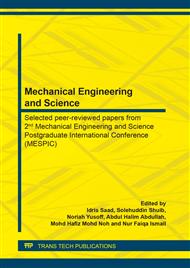[1]
A. K. F. Klocke, D. Welling*, J. Dieckmann, Titanium Parts for Medical Sector Made by Wire-EDM,, no. May 2012, (2015).
Google Scholar
[2]
S. Prasad, K. T. Mannan, and A. Krishnaiah, Surface Integrity Characteristics in Wire Electrical Discharge Machining of Titanium Alloy during Main cut and Trim cuts,, Mater. Today Proc., vol. 4, no. 2, p.1500–1509, (2017).
DOI: 10.1016/j.matpr.2017.01.172
Google Scholar
[3]
S. Suresh, D. A. Hamid, M. Yazid, N. R. Che Daud, and N. N. L. Mohd Din, An Investigation into the Impact of Flexural Elastic Modulus on the Dimensional Instability in CNC Turning of Titanium Alloy Grade,, J. Mech. Eng., vol. 3, no. 2, p.73–85, (2017).
Google Scholar
[4]
A. Pramanik, Problems and Solutions in Machining of Titanium Alloys,, Int. J. Adv. Manuf. Technol., vol. 70, no. 5–8, p.919–928, (2014).
DOI: 10.1007/s00170-013-5326-x
Google Scholar
[5]
A. Pramanik, M. N. Islam, A. Basak, and G. Littlefair, Machining and Tool Wear Mechanisms during Machining Titanium Alloys,, Adv. Mater. Res., vol. 651, p.338–343, (2013).
DOI: 10.4028/www.scientific.net/amr.651.338
Google Scholar
[6]
R. Chalisgaonkar and J. Kumar, Process capability analysis and optimization in WEDM of commercially pure titanium,, Procedia Eng., vol. 97, p.758–766, (2014).
DOI: 10.1016/j.proeng.2014.12.306
Google Scholar
[7]
V. R. Surya, K. M. V. Kumar, R. Keshavamurthy, G. Ugrasen, and H. V Ravindra, Prediction of Machining Characteristics using Artificial Neural Network in Wire EDM of Al7075 based In-situ Composite,, Mater. Today Proc., vol. 4, no. 2, p.203–212, (2017).
DOI: 10.1016/j.matpr.2017.01.014
Google Scholar
[8]
J. B. Saedon, N. Jaafar, and M. Azman, Multi-objective Optimization of Titanium Alloy Through Orthogonal Array and Grey Relational Analysis in WEDM,, Procedia Technol., vol. 15, p.832–840, (2014).
DOI: 10.1016/j.protcy.2014.09.057
Google Scholar
[9]
K. Mouralova, J. Kovar, L. Klakurkova, T. Prokes, and M. Horynova, Comparison of Morphology and Topography of Surfaces of WEDM Machined Structural Materials,, Meas. J. Int. Meas. Confed., vol. 104, p.12–20, (2017).
DOI: 10.1016/j.measurement.2017.03.009
Google Scholar
[10]
A. V Linovsky and A. P. Morgunov, The Influence of Steel 35 Wire EDM Parameters on the Surface Roughness and Morphology,, J. Mech. Eng., vol. 14, no. 2, p.36–48, (2017).
Google Scholar
[11]
L. Manufacturing and L. Sigma, Experimental Study of Process Parameters through Dissimilar Form of Electrodes in EDM Machining Experimental Study of Process Parameters through Dissimilar Form of Electrodes in EDM Machining,, no. January, p.0–31, (2016).
DOI: 10.2139/ssrn.2947443
Google Scholar
[12]
S. R. Pujari, R. Koona, and S. Beela, Surface Integrity of Wire EDMed Aluminum Alloy: A Comprehensive Experimental Investigation,, J. King Saud Univ. - Eng. Sci., (2016).
DOI: 10.1016/j.jksues.2016.12.001
Google Scholar
[13]
P. J. S, H. V Ravindra, G. Ugrasen, N. P. G. V, and Y. S. Rammohan, Study of Surface Roughness and AE Signals while Machining Titanium Grade-2 Material using ANN in WEDM,, Mater. Today Proc., vol. 4, no. 9, p.9557–9560, (2017).
DOI: 10.1016/j.matpr.2017.06.223
Google Scholar
[14]
I. Maher, A. A. D. Sarhan, and H. Marashi, Effect of Electrical Discharge Energy on White Layer Thickness of WEDM Process, vol. 1–3. Elsevier Ltd., (2016).
DOI: 10.1016/b978-0-12-803581-8.09154-2
Google Scholar
[15]
M. Y. Ã and Y. Liu, International Journal of Machine Tools & Manufacture Design , analysis and experimental study of a high-frequency power supply for finish cut of wire-EDM,, Int. J. Mach. Tools Manuf., vol. 49, no. 10, p.793–796, (2009).
DOI: 10.1016/j.ijmachtools.2009.04.004
Google Scholar
[16]
S. Prasad Arikatla, K. Tamil Mannan, and A. Krishnaiah, Parametric Optimization in Wire Electrical Discharge Machining of Titanium Alloy Using Response Surface Methodology,, Mater. Today Proc., vol. 4, no. 2, p.1434–1441, (2017).
DOI: 10.1016/j.matpr.2017.01.165
Google Scholar
[17]
B. E. J. Lee, S. Ho, G. Mestres, M. Karlsson Ott, P. Koshy, and K. Grandfield, Dual-topography Electrical Discharge Machining of Titanium to Improve Biocompatibility,, Surf. Coatings Technol., vol. 296, p.149–156, (2016).
DOI: 10.1016/j.surfcoat.2016.04.024
Google Scholar
[18]
B. R. Chauhan, P. H. Agarwal, and S. D. Daxini, A Review on the Conventional and Wire-Electro Discharge Machining of Titanium and Its Alloys,, Int. J. Recent Sci. Res., vol. 9, no. 3, p.25311–25322, (2017).
Google Scholar
[19]
A. Kumar, V. Kumar, and J. Kumar, An Investigation into Machining Characteristics of Commercially Pure Titanium ( Grade-2 ) using CNC WEDM,, Appl. Sci. Mater., vol. 159, p.56–68, (2012).
DOI: 10.4028/www.scientific.net/amm.159.56
Google Scholar
[20]
C. Deneş et al., Investigation of the Surface Integrity and Fatigue Strength of Inconel718 After Wire EDM and Machine Hammer Peening,, Int. J. Mater. Form., vol. 50, no. 5–8, p.611–624, (2015).
DOI: 10.1007/s12289-015-1249-4
Google Scholar
[21]
J. F. Liu, Y. B. Guo, T. M. Butler, and M. L. Weaver, Crystallography, Compositions, and Properties of White Layer by Wire Electrical Discharge Machining of Nitinol Shape Memory Alloy,, Mater. Des., vol. 109, p.1–9, (2016).
DOI: 10.1016/j.matdes.2016.07.063
Google Scholar
[22]
F. Klocke, L. Hensgen, A. Klink, L. Ehle, and A. Schwedt, Structure and Composition of the White Layer in the Wire-EDM Process,, Procedia CIRP, vol. 42, no. Isem Xviii, p.673–678, (2016).
DOI: 10.1016/j.procir.2016.02.300
Google Scholar


